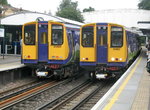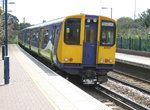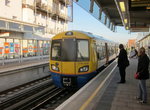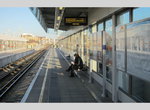London Overground
East London Line
Photo locations: Highbury & Islington, Dalston Junction, Haggerston, Hoxton, Shoreditch High Street, Shoreditch, Whitechapel, Shadwell, Wapping, Rotherhithe, Canada Water, Surrey Quays, New Cross, New Cross Gate, Brockley, Forest Hill, Honor Oak Park, Sydenham, Crystal Palace, Penge West, Anerley, Norwood Junction, West Croydon, Queens Road Peckham, Peckham Rye, Denmark Hill, Clapham High Street, Wandsworth Road, Clapham Junction
I railfanned on the East London Line, formerly part of the London Underground and now newly reopened as a London Overground line, on its full opening day. There were various festivities going on. Garlands of orange and white balloons around most of the station entrances; free travel on the ELL for the day, bringing out lots of passengers -- not all of them railfans, many families with children having a day out in the warm sunshine, visiting areas of London unfamiliar to them; "street" theatre and live music on the trains, courtesy of Media Studies students from Goldsmith's College of London University, which is situated at New Cross.
The northern end of the line between Dalston Junction and Hoxton uses the old North London Railway (NLR) brick viaduct, which has been disused for decades; a brand-new reinforced-concrete viaduct links this across the disused Bishopsgate Goods Yard to the old ELL line between Whitechapel and New Cross Gate, with Shoreditch High Street station on this new section. At New Cross Gate station, the physical link to the old London, Brighton and South Coast Railway (LBSC) main line has been restored to allow through running to West Croydon and Crystal Palace.
The trains themselves -- new Bombardier class 378/2 'Capitalstar' four-car units, giving a pretty smooth ride, are generally liked by the travelling public. The line was formerly operated by 50-year old Underground A60 stock. The mostly white livery will attract graffiti, though. All seating longitudinal -- but comfortably upholstered; and, a first for London, you can see all the way through the four cars, as on the Paris Meteor line, and this feature attracted favourable comment from many of the passengers. This variety of the class 378 has third rail collection only; other subclasses, for use on other parts of the Overground, have dual electrification.
The stations. Dalston Junction to Surrey Quays inclusive had been open for a preliminary service, Mondays to Fridays only, since 27 April, but were still pristine. Dalston Junction, Haggerston, Hoxton and Shoreditch High Street are brand new; Whitechapel (ELL platforms), Shadwell, Wapping, Rotherhithe, Canada Water (ELL platforms) and Surrey Quays had been completely closed for the refurb, so the renewal could be thorough. The rest of the stations -- New Cross, New Cross Gate to West Croydon inclusive, and Crystal Palace -- had never closed, because they are also served by National Rail trains on other lines. These stations have been transferred to Transport for London (TfL) control and will be refurbished as London Overground stations. The refurb is ongoing and some of them still look scruffy, though the platform signage had become Overground style in every case. A fair number of the stations are still not fully disabled accessible, though the new ones had to be. The below-ground platforms at several of the stations are decorated with artwork with some local relevance, a nice touch. And a couple of general grumbles -- no toilet facilities on any of the stations, and the platforms are rather narrow at the new elevated stations, Haggerston and Hoxton, and the old tunnel ones, Shadwell, Wapping and Rotherhithe.
Dalston Junction. A brand new four-track station (two island platforms), with terminal tracks in the middle and through tracks on the outside, which will enable half the service to continue to Highbury & Islington (North London Line platforms) from next year. The platforms are slightly below ground level, so it has the 'feel' of an underground station. There is a design resemblance to St Pancras (First Capital Connect's below-ground platforms) and City Thameslink station -- clean, modern and a bit clinical. The surface building is a rather unattractive concrete block-house. And as far as I could see, no signage was up yet for the walking route to Dalston Kingsland station, despite the interchange being shown on the map. Kingsland was closed for renovation at the time of my visit, but it has since re-opened, so let's hope some signs have gone up by now.
Haggerston. An elevated station on the old NLR section. The side platforms are cantilevered out from the viaduct; lifts provide for accessibility, with the lift tower incorporated into the design of the entrance building on the east side of the viaduct, which is still a bit block-house, but much more attractive than Dalston Junction.
Hoxton. Another elevated station on the viaduct, with side platforms and lifts. There is a nice photo-opportunity view from the south end of the southbound platform, as the track curves westwards and so the City of London skyline can be incorporated into train photos -- not quite the equivalent of New York's Smith/9th, but a nice picture anyway. There is no entrance building as such, because the street-level facilities are incorporated into three arches of the ex-NLR viaduct, giving a quite attractive design effect to the entrances on either side of the line. (London Overground did something similar at the new Imperial Wharf station on the West London Line, which opened in 2009.)
Shoreditch High Street. The station is on the completely new section of viaduct RoW linking the old NLR viaduct to the old ELL tunnels. At platform level, you have the 'feel' of a below-ground station, like Dalston Junction, because the station is enclosed and windowless, but it is actually elevated. The station entrance is in the Wheeler Street underbridge beneath the viaduct, so there is no street-level building as such. The land immediately around the entrance is still undeveloped. The station is being advertised by TfL as providing access to The City, since it is only a few minutes' walk from Liverpool Street; so why wasn't an entrance put at the end nearest to Liverpool Street?
Whitechapel. A great contrast to the first four stations, since Whitechapel station is an original from 1884. No balloons here, but the station entrance, a shopfront in the ground floor of a Victorian terrace building, now sports both Underground and Overground roundels. The walking routes from the entrance to both lines are quite rambling, involving lots of stairs, and they have a dark, Victorian feel to them. No cleaning or refurbishment seems to have taken place except on the ELL platforms themselves. As one of the main connecting points on to the new line, couldn't Whitechapel station as a whole have been given at least a superficial spruce-up? An oddity at Whitechapel is the fact that the 'Underground' platforms are in the open air while the 'Overground' platforms are below ground!
Shadwell. Platform level is below-ground, and is unchanged but cleaned up and redecorated, with some of those artworks. The two entrance buildings -- into two parallel streets, Cable Street and Cornwall Street -- are very much alike, and are newly built in brick, preferable to the concrete of the stations further north. The Cornwall Street entrance is very close to Shadwell station on the Docklands Light Railway (DLR), which here is up on the old London & Blackwall Railway viaduct, though the connection is still 'out-of-system', requiring the passenger to cross one narrow, quiet street. The ELL station is not disabled-accessible -- you have to ascend narrow staircases from the ends of the two side platforms to the above-track level before you can board a lift to the surface -- though the DLR station is.
Wapping. Essentially unchanged from Underground days, but nicely refurbished. The layout is similar to Shadwell, with below-ground side platforms and narrow staircases at the ends of the platforms to negotiate before you reach the lifts. There is only one street entrance here, on the south side of Wapping High Street; the frontage looks modern, but may have simply been re-tiled. The reopening of Wapping station re-creates convenient access to arguably London's nicest pub, the Prospect of Whitby, dating from 1520, which is about ten minutes walk east of the station. Wapping and Rotherhithe stations are only a short distance apart, but that short distance is historically significant -- the two stations stand at the north and south portals, respectively, of Marc Isambard Brunel's Thames Tunnel, completed in 1843, the first under-water tunnel in the world. Plaques in both stations commemorate this fact.
Rotherhithe. Similar at platform level to the previous two stations, with below-ground side platforms just outside the Thames Tunnel's portal, accessed by narrow staircases at the platform ends. Here, however, there are escalators up to the surface from the above-platform bridge. The surface building is in my view the most attractive on the line -- the original little single-storey Victorian building, beautifully refurbished. Top marks to Transport for London (TfL) for this one. (The old Shoreditch station, now closed and by-passed, is architecturally similar, but is now sadly derelict and graffiti-ridden.) Nearby is the Brunel Museum, giving the history of the Thames Tunnel. From the Rotherhithe platforms one can look along the tunnel and see the lights of the next station, Canada Water -- giving a Paris Metro feel to things. The reason the two stations are so close together is that Canada Water station was added in 1999 for interchange with the Jubilee Line.
Canada Water. This could not be a greater contrast to the previous three stations. Like the rest of the Jubilee Line Extension stations, it is built on a generous scale, and architecturally impressive. The escalators ascend into a round clerestory surface building reminiscent of Charles Holden's Piccadilly Line stations. Here, Overground and Underground are both below ground, with the Jubilee Line the deeper of the two, and copious escalators and lifts link all levels. There is an adjoining bus station, and here I found an odd blunder. The sign outside the stations is a stainless-steel pillar, currently covered by a plastic jacket, which has on it the Underground and Buses roundels -- and the National Rail logo! Canada Water station has never been served by National Rail, and the third symbol should be the Overground roundel. I wonder what symbols lie underneath the jacket, on the pillar itself...
Surrey Quays (formerly Surrey Docks). One of the original ELL stations, but little remains of the old station. At street level above the tracks, the building is a new one in glass and steel in the Overground's current style. Platform level is older -- the side platforms are in the open air here, and on the northbound platform the brackets supporting the awning are the original Victorian wrought-iron work. There are cast-iron pillars supporting the skew bridge on which the street-level station building stands, and these too seem original.
New Cross. Despite the extension, New Cross is still on a little stub-end branch. The last few hundred yards are single track, as in Underground days, leading to a single terminus platform at the northeast side of the layout, the through platforms being served by Southeastern trains. I didn't leave the station here, but I have passed it in the street recently and the street-level building above the tracks is essentially unchanged in appearance from before. New Cross and New Cross Gate stations are only a few hundred yards apart along the street, but they provide connection with two different National Rail routes. Both provide access to Goldsmith's College.
New Cross Gate. Here the layout had previously been essentially identical to that at New Cross, with terminating Underground trains serving a single terminus platform at the northeast side. Now this track has been connected through to the Brighton main line and serves southbound ELL trains; northbound ELL trains use the southwestern platform, as the four-track mail line here has the usual NYCT arrangement, with the express tracks in the middle. The station itself is largely unchanged -- a pleasant little single-storey building faces on to the road bridge above the tracks, with 'NEW CROSS GATE' carved into the stone lintel over the entrance. No balloons here; the only clue to the new situation is the Overground roundel outside. All the intermediate stations between New Cross Gate and Norwood Junction (exclusive) are side-platform stations without platforms on the express tracks. The tracks are in open cut some of the way, leading to a visual resemblance to NYCT's Brighton line. All these stations are still served Southern trains running out of London Bridge terminus as well as the new Overground service, giving a sharp enhancement of service to them. One nice touch at most of the ex-Southern stations is the provision of hanging baskets on the platform lamp-posts -- the flowers must be artificial, for low maintenance, but at least an effort at beautification has been made.
Brockley. This station had the misfortune to be rebuilt in the 1960s when 'CLASP' prefabricated buildings were in fashion. There is nothing you can do to make CLASP buildings attractive; they look like several shipping containers bolted together. Here the CLASP hut is well above street level, east of the tracks. At Brockley an effort is being made; the station has been generally refurbished, and when I was there a large group of (presumably) local volunteers was planting out a garden on the street frontage bank sloping up to the station, and the balloons were in evidence.
Forest Hill. This station is another CLASP monstrosity, at ground level on the west side of the tracks, but in this case there are no redeeming features. Refurbishment by TfL has barely started despite the fact that it is one of the busiest stations on the line, being right in the centre of the Forest Hill neighbourhood. I did not alight here.
Honor Oak Park. The American spelling of 'Honor' is notable! Currently under refurbishment. The street-level building, on the bridge above the tracks, is a pleasant little single-storey Victorian design painted in overall white. Overground exterior signage and the balloon garland were present. The neighbourhood around the station seemed pleasant and leafy, looking good in the sunshine.
Sydenham. This station has its building at ground level at the east side of the line. This is a pleasant little twin-gabled building dating back to LBSC days, and with refurbishment well advanced, it was the most attractive station on the ex-Southern section of the ELL. And the balloons were there. The branch to Crystal Palace leaves the main line here, by a flying junction.
Crystal Palace. This station dates back to the days when the Palace itself -- destroyed by fire in 1936 -- was a major tourist attraction. This large ex-LBSC station was originally the smaller of the two at Crystal Palace; the High Level station, built by the London Chatham and Dover Railway, was even bigger, but it closed in 1954 and has vanished. The Low Level station that survives is in two parts, in a V-shape; the East Station, the original one, has four platforms, nos. 3-6, two of them terminal, and has been relatively little used in recent years. The terminus platforms in the East Station, nos. 3 & 5, are the ones taken over by the Overground. The West Station, through lines with two side platforms, nos. 1 & 2, carries the majority of the Southern trains serving the station. Consequently, when a new entrance building was constructed a few years ago in a glass-and-steel pavilion design reminiscent of the old Palace itself, it was built over platforms 1 & 2. The original Victorian street-level building above platforms 3-6 is 'listed' and cannot be demolished, but is not used. And thereby hangs an unfortunate tale. If you arrive at Crystal Palace to catch an ELL train, you enter via the pavilion, go down a slope to the level of the footbridge over platforms 1 & 2, across the footbridge, and then up some steps and into the East Station through its side wall, to a landing from which you can descend steps to platform 3. But suppose the next ELL train leaves from platform 5. You have to go up another long flight to the original entrance level, just inside the locked red doors from the street, and finally down a very long flight to get to platform 5. Not just disabled-inaccessible, but pretty tiring even for the able-bodied! London Overground surely must reopen one of the red doors and install a couple of ticket gates just inside it. No need for any ticket facilities -- most people in London now have Oyster cards anyway, and the few that don't can stroll a few yards along the road to the pavilion to buy a ticket. On the positive side, the historic East Station has been nicely refurbished, and there were balloons outside the Pavilion. The external signage was still in Southern and not Overground style, though.
2016 Update: Everything has changed for the better. TfL has indeed reopened the original, historic station building after a total refurbishment for which it got an award (see the plaque in one of the pictures). The red doors mentioned above now painted green, and open into a spacious booking hall, with a café. The station is now accessible with lifts to all platforms from this booking hall, though most passengers still use the impressive staircases mentioned previously. Now, though, there's no going up, down and up again to exit the station - it's straight out from the top of the staircase through fare-control and out the doors. The little greenhouse-like pavilion that formed the entrance and booking hall in recent years has gone, and the space it occupied now provides bicycle parking and an emergency exit. The station now looks beautiful, and seems well-used! 'Build it and they will come.'
Penge West, Anerley and Norwood Junction. Continuing along the Brighton main line, these are the next three stations. I didn't alight them; their platform signage had become Overground style, but otherwise they seemed little changed from their previous Southern incarnation. Penge West showed little sign of refurbishment, but one must hope that the stations will all get at least a coat of paint. One lady from Anerley, overheard, approved of the new timetable. Now that their service to West Croydon station is provided by Overground, they have a regular Southern service to East Croydon station, for convenient connections to Gatwick Airport, Brighton and other South Coast destinations. Maybe the timetable planners aren't such numbskulls after all.
Incidentally, at all of the ex-Southern stations, the platform PA announcements, which come from a centralised recorded system, said: 'The next train from platform so-and-so is a London Overground service to Dalston Junction, calling at ... New Cross Gate, Canada Water, Rotherhithe ...' Duh. What about Surrey Quays, guys?
West Croydon. What can we say about this poor-relation station? It is a dump compared with main-line East Croydon, with its smart new entrance building above the tracks and convenient connections to the Tramlink station right outside the door. West Croydon has an entrance in Station Road pointing straight at the tram stop and bus station -- but this door is locked out of use, and everyone has to use the other one around the corner in London Road. Integrated public transport, TfL? Now that TfL, in the form of Overground, has taken over the station, surely reopening the Station Road entrance must be a high priority. The main entrance building in London Road is one of the old Southern Railway's unbeautiful concrete efforts from the inter-war years, now looking tired. Its signage is still (new) Southern-style, with nothing to suggest a change of proprietorship to Overground as yet. And no balloons either. I had expected that the ELL would take over the terminal platform 1 from Southern. But no; arriving ELL trains empty at platform 4, the main down through platform, go forward to relay, and return into the main up through platform 3, to load for the return journey, sharing platforms 3 & 4 with through Southern trains to and from Sutton and beyond. Only the now relatively rare terminating Southern trains use platform 1. There is no platform 2 -- there used to be one, a short terminal platform, for terminating Wimbledon trains, but as the Wimbledon service has been provided by the trams since 2000, platform 3 has been lengthened over the site of platform 2.
My verdicts. Nicest station on the line -- Rotherhithe, without a doubt. Overground obviously think so too, as they give it pride of place on their website. Nicest new station -- Hoxton. Nicest ex-Southern station -- Sydenham. Nastiest new station -- Shoreditch High Street. Why have an elevated station and then box it in so that it feels like a below-ground one, with no view? And why put its only entrance at a place that is handy for nothing? Nastiest station overall - Forest Hill, but that isn't Overground's fault -- British Rail put up the CLASP building. Dishonourable mentions in the contest for nastiest station -- West Croydon and Whitechapel.
Overall, though, a good job has been done. Some UK railfans, including me, have had doubts about this scheme, which was a pet one of former Mayor Ken Livingstone. One must always welcome a new rail transit facility, but is hard to see a service, however frequent and comfortable, can be a big success if it studiously avoid the main centres of employment ! It goes nowhere near the West End, passes some way west of Canary Wharf, and only pretends to serve The City. However, one must now admit that passengers commuting from the stations on the old Brighton main line to the West End or Canary Wharf, given a frequent service with comfortable new trains, may decide that interchange at Canada Water beats trying to reach their final destination from London Bridge National Rail station. And once the extension to Highbury and Islington opens, Hoxton and Haggerston passengers may go for the interchange with the Victoria Line to reach the West End. Time will tell.
North London Line =
Photo locations: Richmond, Kew Gardens, Gunnersbury, South Acton, Acton Central, Willesden Junction, Kensal Rise, Brondesbury Park, Brondesbury, West Hampstead, Finchley Road & Frognal, Hampstead Heath, Gospel Oak, Kentish Town West, Camden Road, Caledonian Road & Barnsbury, Highbury & Islington, Canonbury, Dalston Kingsland, Hackney Central, Homerton, Hackney Wick, Stratford
Gospel Oak-Barking (GOBLIN) Line
Photo locations: Gospel Oak, Upper Holloway, Crouch Hill, Harringay Green Lanes, South Tottenham, Blackhorse Road, Walthamstow Queen's Road, Leyton Midland Road, Leytonstone High Road, Wanstead Park, Woodgrange Park, Barking
Watford DC Line
Photo locations: Euston, South Hampstead, Kilburn High Road, Queen's Park, Kensal Green, Willesden Junction, Harlesden, Stonebridge Park, Wembley Central, North Wembley, South Kenton, Kenton, Harrow & Wealdstone, Headstone Lane, Hatch End, Carpenders Park, Bushey, Watford High Street, Watford Junction
West London Line
Photo locations: Willesden Junction, Shepherd's Bush, Kensington (Olympia), West Brompton, Imperial Wharf, Clapham Junction
Photo Gallery
| Five Random Images | ||||
 Image 120610 (341k, 1044x788) Photo by: Bernard Chatreau Location: Kew Gardens |  Image 120625 (334k, 1044x788) Photo by: Bernard Chatreau Location: West Brompton |  Image 143751 (321k, 1044x788) Photo by: Bernard Chatreau Location: Haggerston |  Image 143754 (293k, 1044x788) Photo by: Bernard Chatreau Location: Hoxton |  Image 143758 (244k, 1044x595) Photo by: Bernard Chatreau Location: Hoxton |
Page Credits
By Fytton Rowland.